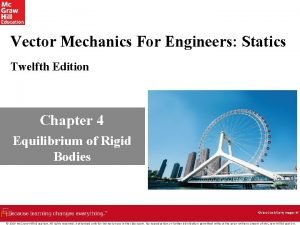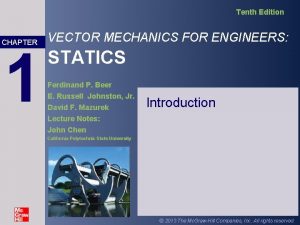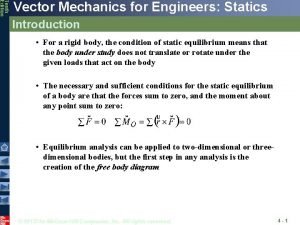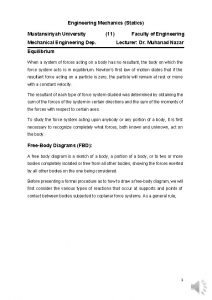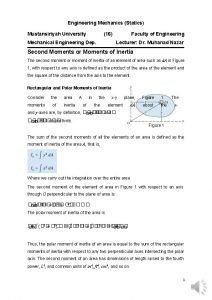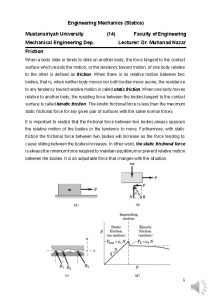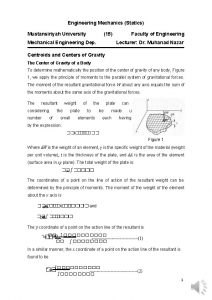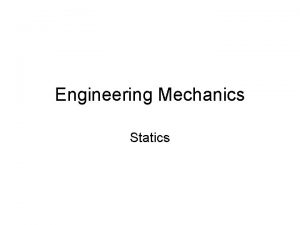Engineering Mechanics Statics Mustansiriyah University 12 Mechanical Engineering






- Slides: 6

Engineering Mechanics (Statics) Mustansiriyah University (12) Mechanical Engineering Dep. Faculty of Engineering Lecturer: Dr. Muhanad Nazar Equations of Equilibrium for a Concurrent, Coplanar Force System The resultant of a concurrent, coplanar force system is a single force through the point of concurrence. When this resultant force is zero, the body on which the force system acts is in equilibrium. The equations necessary to ensure a zero resultant are the equations of equilibrium. One complete set of equations of equilibrium for a concurrent, coplanar force system is. ∑ �� =0 �� , Another set of equations which assure equilibrium for a concurrent, coplanar force system is ∑ �� =0 �� , ∑ �� =0 �� Where A is not on the y axis A third set of independent solutions can be shown to be ∑ �� =0 �� , ∑ �� =0 �� Where line AB does not pass through the point of concurrence of the forces of the system Example 1: The 300 lb shaft M and the 500 lb shaft N are supported as shown in the Figure. Neglecting friction at the contact surfaces P, Q, R, and S, determine the reaction at R and S on shaft N. 1

From the FBD of M, the equation +↑ ∑ �� =0 �� , Q sin 40 =300 , ∑ �� = �� sin 40 − 300 = 0 �� Q = 467 , 40 o on M From the FBD of N, the equation +↑ ∑ �� =0 �� , ∑ �� = �� − 500 − ���� 40 = 0 , S = 800 lb ↑ on N �� Also from the FBD of N, the equation + → ∑ �� =0 �� , ∑ �� = �� − �� cos 40 = 0 �� R = 467 cos 40 , R = 358 lb → on N Example 2: Determine the magnitudes of the forces C and T, which, along with the other three forces shown, act on the bridge-truss joint. 2

Equilibrium of Bodies Acted on by Two Forces or Three Forces When a body is acted on by only two forces, it is called a two-force body or member. If a body is held in equilibrium by two forces, they must be collinear equal in magnitude, and opposite in sense. A three- force member is one which is acted on by three and only three nonparallel forces. When a body is held in equilibrium by three nonparallel forces, they must be concurrent and coplanar. Example 1: The center of gravity of 90 lb bar is 10 ft from B measured along the bar. All surfaces are smooth. Determine the reactions at A and B on the bar The FBD of the bar shows that is held in equilibrium by three forces, and since FA and the 90 lb force intersect at C, FB must also pass through point C, which determines the slope of FB as 15 vertical to 8 horizontal. The equation of equilibrium in the vertical direction becomes +↑ ∑ �� =0 �� , = ∑ �� �� 15 17 �� − 90 = 0 �� FB = 102 lb The slop is 15 vertical to 8 horizontal on AB The equation of equilibrium in the horizontal direction becomes + → ∑ �� �= � 0 , ∑ �� = �� − 8 �� =0 �� �� �� 17 FA = 48 lb → on AB 3

Equilibrium of Bodies Acted on by Nonconcurrent, Coplanar Force System The resultant of a nonconcurrent, coplanar force system is either a single force or a couple. The equation which eliminate all possible resultants constitute a complete set of equations of equilibrium. One complete set of equations of equilibrium for a nonconcurrent, coplanar force system is. ∑ �� =0 �� , ∑ �� =0 �� Where A is any axis perpendicular to the plane of the forces or any point in the plane. ∑ �� = 0 , ∑ �� =0 �� �� �� Are another complete set of equations of equilibrium, provided the line AB is not perpendicular to the x- axis. Another complete set of equations of equilibrium for this system can be written as ∑ �� = 0 , ∑ �� =0 �� �� �� Where points A, B, C are not collinear Example 1: The tension in the spring in the pin-connected structure shown in the Figure is 540 lb. The weights of the members and friction at all contact surfaces can be neglected. Determine the horizontal and vertical components of the pin reaction at B on member EB. From the FBD of the entire structure, the equation ∑ �� =0 �� + ∑ �� = �� (6 tan 36 + 6 tan 42) + 1120 (8) = 0 �� �� 9. 76 �� + 8960 = 0 �� �� = − 918 �� 4

�� = 918 lb ← on EB �� From the FBD of EB, the relation, ∑ �� =0 �� becomes Bx = Ex= -918, Bx= 918 Ib on EB From FBD of Figure b, the relation ∑ �� =0 �� + ∑ �� (6) + 540(2) = 0 = �� (6 tan 42) + �� �� 6�� = 3880 , �� = 647 lb ↓ on BE �� �� Example 2: Body G weighs 1500 lb, and the weights of all other members can be neglected. Determine the horizontal and vertical components of the force exerted by the pin at A on member AB. Friction may be neglected at all contact surfaces. The roller E is pinned to the member AB. 5



